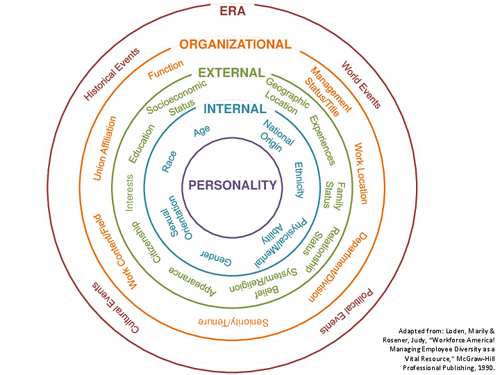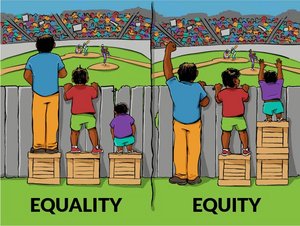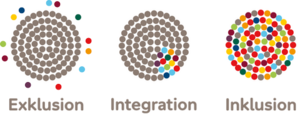Diversity-Sensitive Teaching — Why?
Bauhaus-Universität Weimar students come to the university with different backgrounds, abilities and experience. They are different from one another in many different ways: social, cultural and linguistic background, financial and family circumstances, gender, age, sexual orientation, physical and psychological disposition, learning style...
Diversity-sensitive teaching creates positive learning opportunities for all students. It allows everyone to participate in courses from an equal vantage point and makes it possible for everyone to contribute their own ideas and experiences and to develop their individual potential. It helps to address and counteract exclusion, inequalities and discrimination in teaching and learning (and beyond).
The consideration of diversity and the equal participation of all members and affiliates of the university in teaching and studies are also prescribed as a legal mandate in the Thuringian Higher Education Act (ThürHG; §5 (7)).
The film »Gender and Diversity in Academic Teaching« explains why inclusive teaching is important.
Aspects of Diversity in Teaching
»Diversity in Teaching« can be divided into two basic aspects:
- Diversity-sensitive and anti-discriminatory teaching design: This refers to one’s own attitude and behaviour, methods used, communication and content preparation.
- Addressing diversity (or individual aspects of diversity) and discrimination as course topics
The website focusses on the first point: diversity-sensitive and anti-discriminatory teaching design.
Diversity-Sensitive Teaching — Tips and Methods
Terminology
Diversity
»Diversity« here refers to recognising and taking into consideration socially constructed and perpetuated forms of difference. This interpretation of the term emerged during the Black Civil Rights Movement in the USA, which aimed to establish equal opportunities and eliminate discrimination.
A corporate approach to the concept of diversity also developed in the USA, partly as a reaction to the legal ban on discrimination: »Diversity Management« is intended to use employees’ diversity for the benefit of corporate goals. »Diversity« is understood in this context as an economically profitable resource that can be managed.
Aspects of Diversity
Diversity has many characteristics and facets, such as gender, social or cultural background, age, physical and psychological disposition. There are visible and invisible aspects, as well as changeable, unchangeable, or difficult to change aspects. The »Diversity Wheel« in Figure 1 provides an initial overview of the various dimensions of diversity and their relationship to the individual.
The different aspects of diversity that make up each individual result in different experiences and perspectives. Depending on the social group to which they belong and the situation, individuals experience different forms of social positioning that expose them to certain forms of discrimination or endow them with certain social privileges. Furthermore, those who belong to multiple marginalised groups at the same time may be subject to multiple forms of discrimination.
When different dimensions of diversity or forms of discrimination come together like at a crossroads (»intersection«), overlap and interact, we speak of »intersectionality« (see Crenshaw, 1989, 1991). It is important here to note that the concept of intersectionality is not an additive model of social oppression. Instead, intersectionality refers to the specific forms of discrimination that individuals and groups experience as a result of different forms of discrimination/privilege interacting (for instance, Black women do not always experience racism in the same was as Black men do, and they do not always experience sexism in the same way as white women). Intersectionality challenges the widespread notion that sexism, heterosexism, racism, ableism, classism and other forms of dominance/subordination are separate systems. Rather, intersectionality understands these elements as fundamentally intertwined, supporting and reinforcing one another.
Socially traditional ideas about different social groups, their members and supposed characteristics and behaviours influence our perception, our expectations, our experiences and ultimately our behaviour towards these individuals or groups. It is therefore important that we critically reflect on our assumptions in order to avoid discriminating against others. The Diversity Department and the Equal Opportunity Office regularly offer workshops and events for students and teaching staff for this purpose.

Discrimination
Discrimination is the unjust distinction and production of differences between individuals based on characteristics that are specific to them, attributed to them and endowed with meaning; crucially, it also includes any resulting marginalisation, disadvantage and exclusion. Disadvantage can occur with regard to material and symbolic resources and/or social access and participation.
At the same time, discrimination establishes, maintains and strengthens the advantages and privileges held by the dominant groups and their members in terms of social status, access to resources, and opportunities for determining living conditions.
Discrimination can occur on various levels: (1) at the individual/interpersonal level, (2) at an institutional level, and (3) at a structural level. It can be intentional or unintentional. The intention of the person discriminating is not relevant, rather it is the effect of the discriminatory action on the individual being discriminated against that is important.
Equal Opportunities
The concept of creating equal opportunities recognises that each individual has different requirements that correspondingly different means and measures are required to open up the same opportunities for everyone. Removing barriers and providing resources helps ensure that people with different backgrounds and specific needs can participate equally in social (including university) life.
 (Accessible document)
(Accessible document)Inclusion
Inclusion means that social or spatial environments are designed in a way that everyone can participate equally and without restrictions. The term is used most often to refer to the participation of individuals with disabilities, but can also be used in a broader sense, i.e. as it relates to other groups that are discriminated against. In contrast to the concept of integration, which assumes that individuals must adapt to the system, the concept of inclusion assumes that the system must adapt to the individuals and their different requirements in order to enable actual participation and equal opportunities. By adapting the social or spatial environment to the needs of everyone, secondary exclusions, such as the social or spatial segregation of individuals or social groups with specific needs or experiences of discrimination, can also be avoided.
Literature
Crenshaw, Kimberlé (1989). Demarginalizing the intersection of race and sex: A Black feminist critique of antidiscrimination doctrine, feminist theory and antiracist politics. University of Chicago Legal Forum, 1989, 139–167.
Crenshaw, Kimberlé (1991). Mapping the margins: Intersectionality, identity politics, and violence against Women of Color. Stanford Law Review, 43(6), 1241–1299.
Dovidio, John F., Miles Hewstone, Peter Glick, & Victoria M. Esses (2010). Prejudice, Stereotyping and Discrimination: Theoretical and Empirical Overview. In John F. Dovidio, et al (Eds.), The SAGE Handbook of Prejudice, Stereotyping and Discrimination (pp. 3–28). Los Angeles: SAGE Publications.
Gomolla, Mechthild (2016). Diskriminierung. In Paul Mecherill (Ed.), Veronika Kourabas, & Matthias Rangger, Handbuch Migrationspädagogik (pp. 73–89). Weinheim & Basel: Beltz.
Kourabas, Veronika (2019). Glossar. Bedeutung und Anwendung zentraler Begriffe im Kontext der Rassismuskritik. In Land Nordrhein-Westfalen (Ed.), Arbeitspapier Denkanstöße für eine rassismuskritische Perspektive auf kommunale Integrationsarbeit Kommunale Integrationszentren NRW in den Kommunalen Integrationszentren – Ein Querschnittsthema (pp. 57–71). Arnsberg: Land Nordrhein-Westfalen. Retrieved from: www.stadt-muenster.de/fileadmin//user_upload/stadt-muenster/v_zuwanderung/pdf/Denkanstoesse_fuer_eine_rassismuskritische_Perspektive_finale_Fassung.pdf
Planning and Preparing Courses
Diversity-sensitive teaching begins before a course even starts:
1. Ask students about their specific needs before the course begins (this can be done via moodle, for example) so that you can include these needs into your planning.
Examples:
- »We want this course to be as inclusive and diversity-sensitive as possible. Do you have any specific requirements or suggestions that should be taken into account for course planning?«
- »We want this course to be as inclusive and diversity-sensitive as possible. We welcome your support in this endeavour. If the design of this course is an obstacle for you for health, personal, family or other reasons, please feel free to contact me and talk to me about your concerns and needs. Please feel free to suggest ideas for solutions. Further information on diversity, equality and inclusion at the Bauhaus-Universität Weimar, including information on advisory services, can be found on the ›Equal Opportunity and Anti-Discrimination‹ website.«
2. Make sure that course materials (literature, videos, etc.) are accessible. Helpful tips can be found on the »Digitale Barrierefreiheit« website. You can find tips on accessible online teaching at the website
»Making Digital Teaching Accessible«.
3. When selecting authors, artists and designers whose texts and works you would like to talk about in the course, pay attention to diversity and include a critical examination of the existing canon in your preparations (e.g. How did this canon come about? What perspectives are missing and what are the social/historical reasons for this? Does the course literature list consist only of works by men, for example, and are there ways to counterbalance this through further research? Is there literature/work that deals explicitly with social exclusions from the canon? etc.)
In the First Session
The first session of the course is particularly important to create a good and anti-discriminatory atmosphere:
- Offer participants the chance to get to know one another and create a positive learning environment.
- Clarify the general course conditions (course language, rooms, times, etc.) and the course requirements.
- Be sure to address students respectfully (e.g. use name tags, make introduction rounds including pronouns, use diversity-appropriate language).
- Promote a respectful culture of discussion. For example, develop a common code of conduct for the course and introduce the concept of error-friendliness (»Konzept der Fehlerfreundlichkeit«).
- Make an effort to relate course content to the lives of your students.
- Make students aware of your availability (office hours, contact options, times when you can be reached) and share examples of potential concerns that students can come to you with.
- Provide information on the Counselling Services provided by the university (student advising, academic advising, Equal Opportunity Officer, Diversity Officer, Representative for the Needs of Students with Chronic Illnesses and Disabilities, Diversity Guides, etc.).
You can find detailed information and tips on how to organise your course’s first session under »Gender und Diversity in der Lehre« in the FU Berlin's »Toolbox-Blog«:»Einen guten Start ins Semester fördern: gender- und diversitätsbewusste Gestaltung der ersten Sitzung einer Lehrveranstaltung«
Throughout the Semester
- Use non-discriminatory, non-stereotypical images and texts in your course materials. Contextualize images and texts that contain discriminatory and/or stereotypical content.
- Include examples from different contexts to establish a connection to students from different backgrounds.
- Make sure you use a variety of methods and use participatory and engaging methods (e.g. small groups, buzz groups) to involve everyone and to give everyone the opportunity to actively participate.
- Make sure that speaking time in the course is balanced.
- Use the two-senses principle so that students with disabilities have the opportunity to access course content through spoken and/or written language (e.g. provide a written description of images).
- Establish a quiet learning environment, repeat important contributions, do not speak too quickly, and face your students so that those with disabilities or those for whom the course language is not their first language can follow well.
- Openly address conflicts, discriminatory remarks, etc. that happen in the course.
Useful approaches and tips for engaging and involving everyone can be found in the overview »Es reden immer die Gleichen? 17 Anregungen für Lehrende« in the FU Berlin’s »Toolbox für Gender und Diversity in der Lehre«.
Designing Exams
- Be aware that different forms of examination have advantages and disadvantages for different students. If possible, provide different options for taking exams.
- Provide support for students with disabilities or chronic illnesses by providing compensation for disadvantages (»Nachteilsausgleiche«). The Representative for the Needs of Students with Chronic Illnesses and Disabilities can help you with this.
- Be approachable when students come to you with questions about exams or graded work (e.g. assignments, term papers, etc.).

